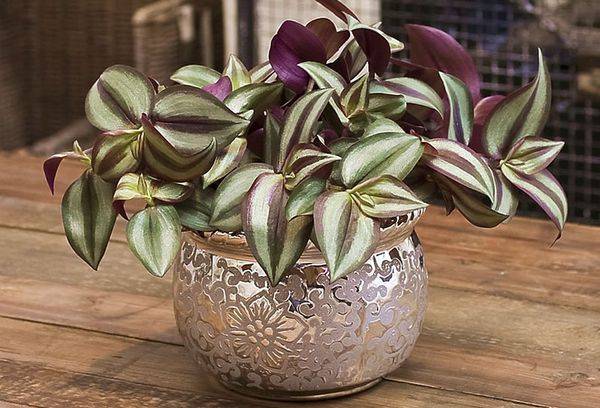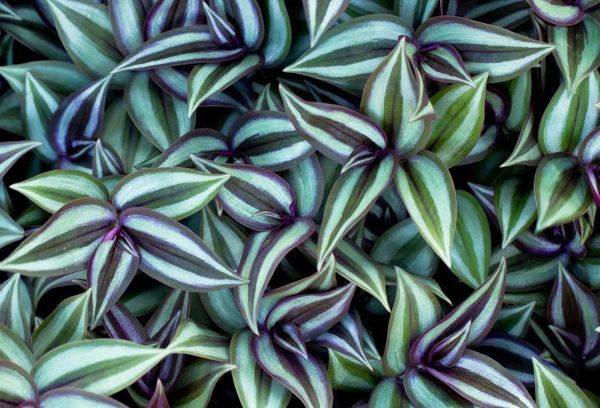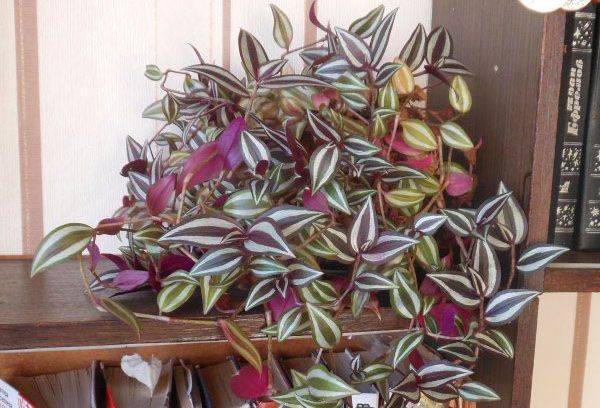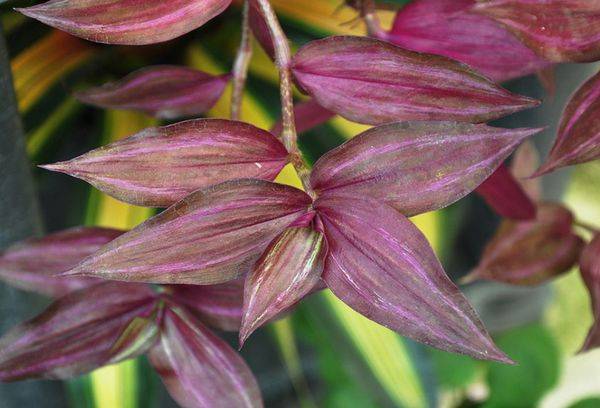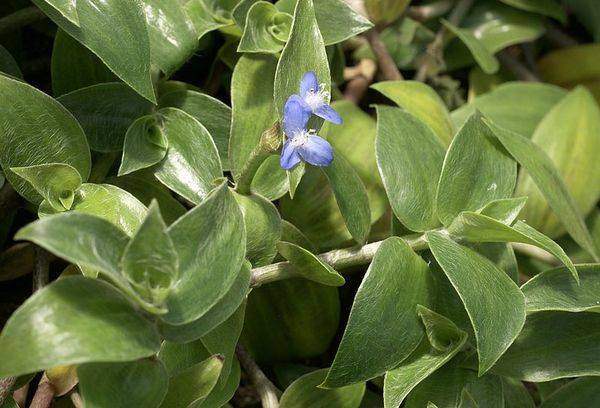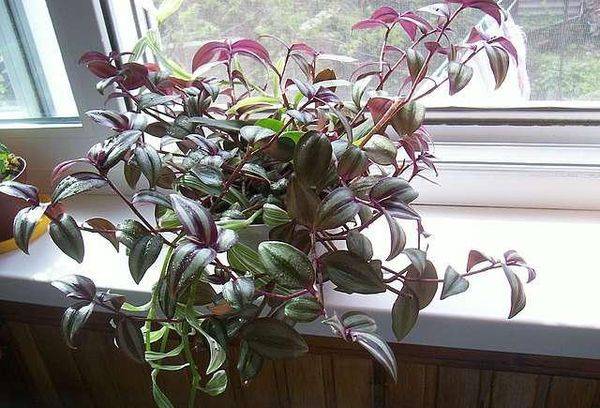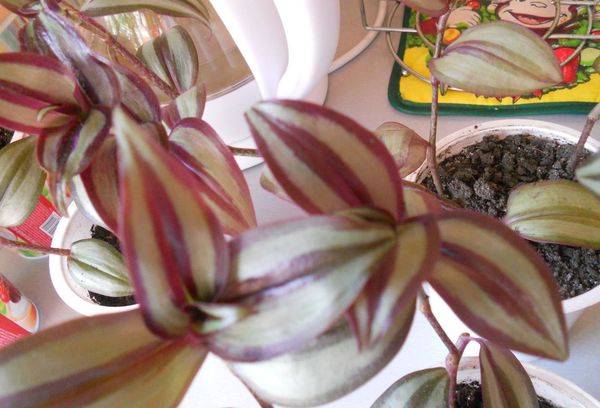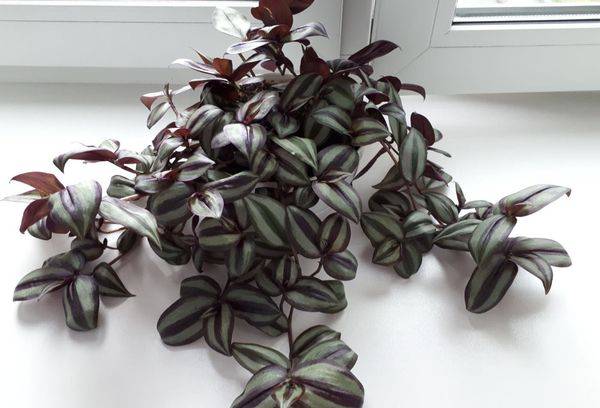Tradescantia zebrin - green doctor on your windowsill
Content:
The bright colors and unusual shape distinguish tradescantia against the background of other indoor plants. Its foliage is cast in silver and covered with longitudinal strips of different colors. Tradescantia zebrin is grown as an ampelous flower. It looks good in flower pots and on balconies, on cabinets and window sills.
Unpretentious, rarely sick, viable, she rightfully takes pride of place in a cohort of indoor flowers. A beginner grower will also cope with her care, but still you need to know some nuances.
Origin and description
The plant belongs to the genus Tradescantia and the family of Commelinas, its closest relative is the golden mustache. Zebrina is an inhabitant of the humid tropics, with many medicinal properties and surprisingly beautiful hanging shoots with dense and bright foliage. The ampel got its name just for the coloring of sheet plates.
Tradescantia zebrin - external signs:
- the stem is long, smooth and dense to the touch, has a cylindrical section;
- shoots creeping, branched and falling, extend up to 1 meter in length;
- leaves are oval, with a pointed end and alternate;
- leaf color: the underside is bright purple, the outer is separated by stripes of different shades - from dark green to deep crimson;
- the root system is superficial, penetrates into the soil shallow.
In wildlife, zebrin in the spring gives small peduncles of lilac or pink color. But in the conditions of the house it rarely blooms. After 5-7 years, the flower loses its visual appeal and beauty, with the help of stem cuttings it is grown again.
Indoor tradescantia purifies the air and saturates it with volatile. Its foliage has a bactericidal and disinfecting effect. This flower creates a favorable atmosphere in the house. This plant always feasts pets.
Varieties and features
The genus tradescantia is numerous, about 100 species are known, differing in height, shape and foliage. Zebrina was originally a separate genus, which was divided into species, but later botanists joined the striped ampel to the tradescantia. Therefore, it is now more correct to talk about the type of zebrin and its varieties. Among them, three most suitable for home gardening stand out:
- Hanging or hanging zebrin (Tradescantia zebrina pendula). Its feature is large bare leaves, hanging stems and medicinal qualities. The bottom of the leaf plate is bright red, along the front side are two wide silver-white stripes on a juicy green background.
- Zebrina purpus (Zebrina purpusii). In this variety, the color borders on the leaf are blurry, from red to green, the lower part is purple. A slight, barely noticeable pubescence passes along the sheet plate.
- Zebrina flocculose (Zebrina flocculosa). Has soft and fleecy leaves of a whitish shade. The plant is characterized by a fast growth rate.
Where to plant
Tradescantia zebrin grows with pleasure at home. Caring for her does not take much time and effort. The plant loves light and moisture, but does not tolerate direct sunlight and excessive watering. Zebrin needs space and air, so the pots with it are suspended or placed higher. For the summer season, it will not be amiss to plant a flower in the open ground - it will adorn the flowerbed wonderfully and will become a bright addition to any landscape design.
Tip
purityis.decorexpro.com/en/ magazine draws attention: when planting in a pot, it must be borne in mind that the roots of tradescantia do not penetrate deeply and are located close to the surface. Therefore, the capacity required is quite wide.
The location. The ideal place for zebrina tradescantia is the eastern and western windows, where there is a lot of diffused daylight and there is no strong heat. The deficit of light negatively affects the appearance of the flower - it weakens and fades.
Environmental conditions. A comfortable temperature range for zebrina is in the range from +20 to + 25 ° C. In the autumn-winter period, it withstands coolness, but not lower than 13 degrees. Tradescantia is a moisture-loving plant, it needs abundant watering and regular spraying. Drying of the soil is not acceptable for it.
Spring and summer - the period of activity of the tradescenter, at this time it builds up green mass and grows. The winter season is characterized by rest, during this period the plant needs a moderate temperature and less watering. Zebrina willingly lives in open ground, if the air temperature is acceptable for its growth and development.
How to care
Tradescantia zebrin is a valuable houseplant. Its leaves are used for medical purposes - they heal wounds and burns, relieve pain, make tinctures against gastrointestinal diseases. This plant is an air filter - it cleans and disinfects the air in the house. Experts say that this flower has a powerful energy effect on people - it calms, improves mood and gives strength.
Basic care measures:
Watering. The soil in the pot with tradescantia zebrina should always remain slightly moist, but not wet. Dry soil can lead to wilting of leaves, and stagnation of moisture - to rotting of the roots.
Top dressing. Zebrin is fertilized only in the stage of active growth - in spring and summer. Good top dressing is complex fertilizers twice a week. Autumn and winter is a time of rest for a flower, therefore it is not fertilized and watered less.
Circumcision. To enhance branching, it is recommended to pinch the tops of the side shoots. After pinching, the bushes look well-groomed - luxuriant and compact. Old and dry branches are regularly cut.
Transplanting and landing tradescantion. At a young age, the zebrin is transplanted annually, adult plants are resettled every 2-3 years. The plant needs loose soil with a neutral or slightly acidic reaction. In the soil, the presence of humus and sand is mandatory. The tradescantion pot should be shallow and of sufficient width with a good drainage layer at the bottom. Reproduction occurs by cuttings, which quickly root in the ground.
The plant loves the air, so it needs regular cultivation and ventilation of the room. The flower grows poorly next to smokers, nicotine adversely affects it.
Problems of growing tradescantia
Tradescantia is characterized by high viability and resistance to disease. It is rarely affected by pests and deteriorates. If a spider mite attacked the plant, wash the leaves and stem with soap and water and dry in the open. Plaque is removed in the same way.
Negative changes in appearance are most often associated with errors in the care of zebra.
Tip
In flower shops usually sell small bushes of tradescantia, intensively flowering. At home, at first it is not recommended to feed the plant so that it adapts to new conditions. After 1-2 weeks, the flower can be transplanted into another pot.
Difficulties and solutions for growing tradescantia:
- leaves fall off due to moisture deficiency and excessive fertilizer of the plant;
- color brightness is lost due to poor lighting;
- spots on the leaves occur with a lack of moisture;
- dryness at the tips of the leaves is due to insufficient humidity in the room;
- the stems are thinned and extended - the reason lies in the incorrect location or weakness of the root system;
- the aged tradescantia will be able to rejuvenate by cutting the shoots to the very bottom at the surface of the soil.
To revive and improve the tradescantia zebrin is obtained only by dividing the mother plant. The prepared part is immediately rooted in a new pot, providing moderate illumination and systematic watering. Cuttings of tradescantia are kept in water for only a couple of days, after which they are rooted in suitable soil.
Tradescantia zebrin will successfully fit into any interior of an apartment, house or office. It is good on the street - on a flowerbed, lawn, alpine hill or near a reservoir. Everyone, even a novice in this business, can grow an unpretentious and vibrant zebrin. Experienced flower growers distinguish tradescantia among other indoor plants due to variegated foliage, one hundred percent survival and excellent adaptation, medicinal qualities and simple care.
